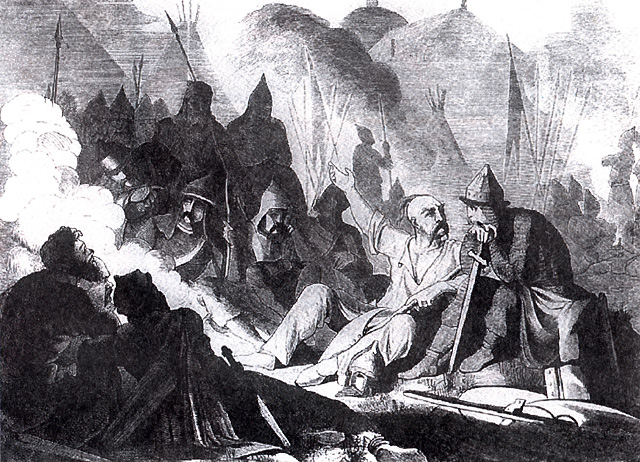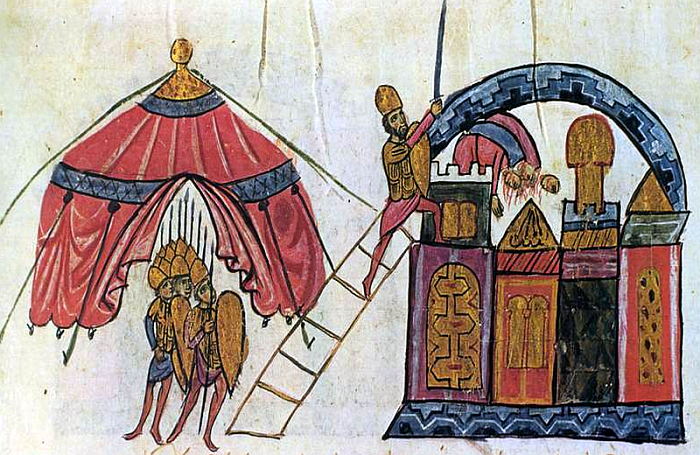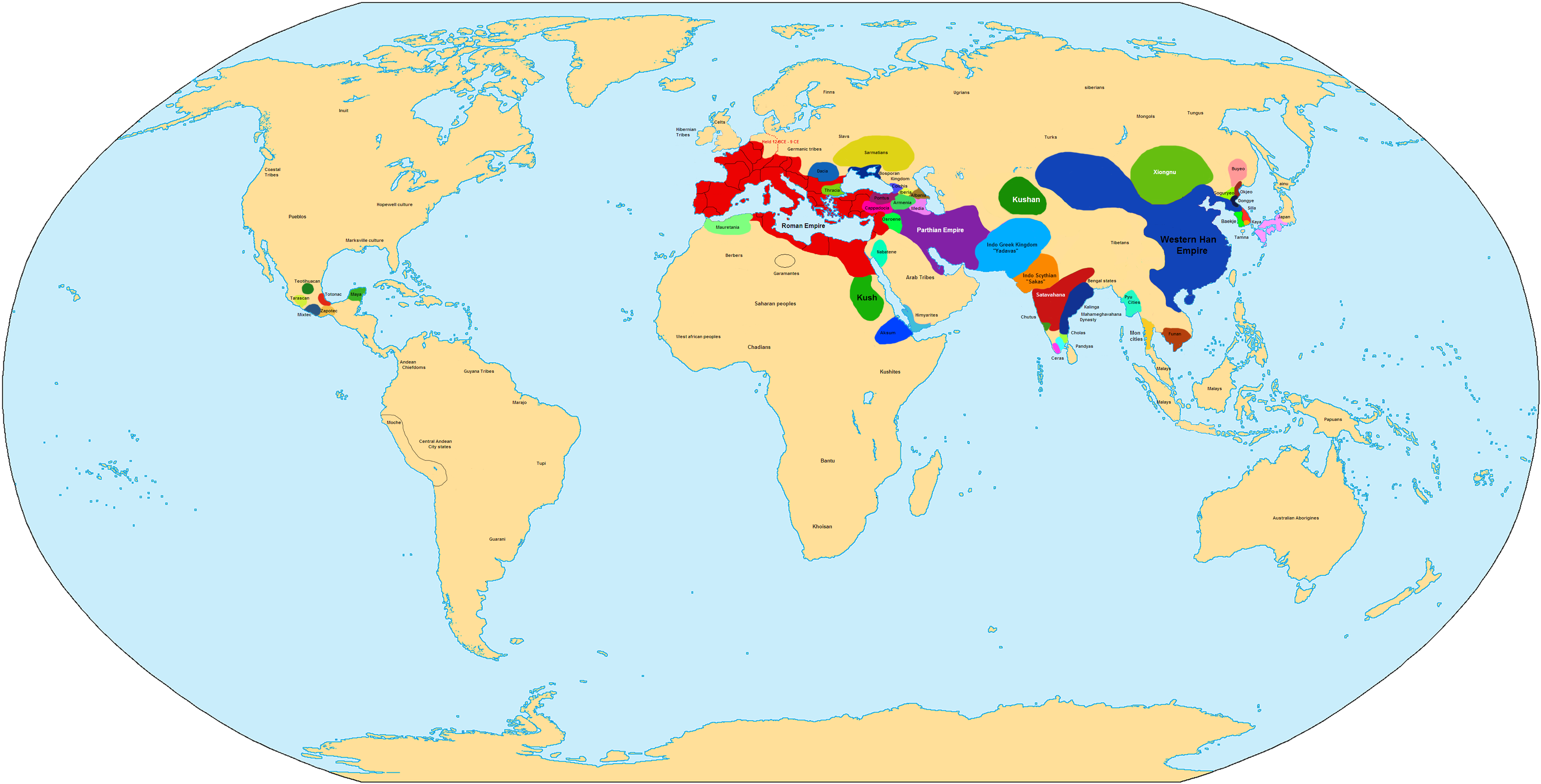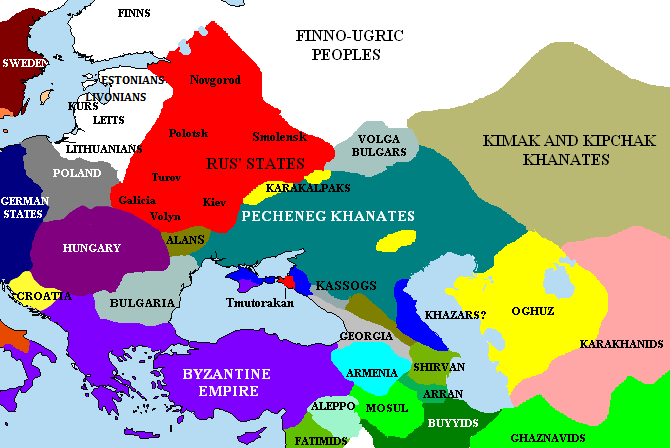|
970
Year 970 ( CMLXX) was a common year starting on Saturday of the Julian calendar, the 970th year of the Common Era (CE) and ''Anno Domini'' designations, the 970th year of the 1st millennium, the 70th year of the 10th century, and the 1st year of the 970s decade. Events By place Byzantine Empire * Emperor John I delegates the war in the Balkans to his brother-in-law, the Domestic of the Schools Bardas Skleros, and to the eunuch general Peter Phokas, who begin to gather a Byzantine army in Thrace. At the news of this, a powerful Kievan expeditionary force (30,000 men), along with many Bulgarians and a Pecheneg contingent, is sent south over the Balkan Mountains. After sacking the Bulgarian stronghold of Philippolis (modern-day Plovdiv), they bypass the heavily defended city of Adrianople, and turn towards Constantinople. * Battle of Arcadiopolis: John I dispatches an elite force (10–12,000 men) to delay the Kievan Rus'. The Byzantines under Bardas Skleros successful ... [...More Info...] [...Related Items...] OR: [Wikipedia] [Google] [Baidu] |
Sviatoslav I Of Kiev
Sviatoslav or Svyatoslav I Igorevich (; Old Norse: ''Sveinald''; – 972) was Prince of Kiev from 945 until his death in 972. He is known for his persistent campaigns in the east and south, which precipitated the collapse of two great powers in Eastern Europe, Khazaria and the First Bulgarian Empire. He conquered numerous East Slavic tribes, defeated the Alans and attacked the Volga Bulgars, and at times was allied with the Pechenegs and Magyars (Hungarians). Following the death of his father Igor in 945, Sviatoslav's mother Olga reigned as regent in Kiev until 962. His decade-long reign over the Kievan Rus' was marked by rapid expansion into the Volga River valley, the Pontic steppe, and the Balkans, leading him to carve out for himself the largest state in Europe. In 969, he moved his seat to Pereyaslavets on the Danube. In 970, he appointed his sons Yaropolk and Oleg as subordinate princes of Kiev and Drelinia, while he appointed Vladimir, his son by his housekeeper ... [...More Info...] [...Related Items...] OR: [Wikipedia] [Google] [Baidu] |
Battle Of Arcadiopolis (970)
The Battle of Arcadiopolis was fought in 970 between a Byzantine army under Bardas Skleros and a Rus' army, the latter also including allied Bulgarian, Pecheneg, and Hungarian (Magyar) contingents. In the preceding years, the Rus' ruler Sviatoslav had conquered northern Bulgaria, and was now menacing Byzantium as well. The Rus' force had been advancing through Thrace towards Constantinople when it was met by Skleros' force. Having fewer men than the Rus', Skleros prepared an ambush and attacked the Rus' army with a portion of his force. The Byzantines then feigned retreat, and succeeded in drawing off the Pecheneg contingent into the ambush, routing it. The remainder of the Rus' army then suffered heavy casualties from the pursuing Byzantines. The battle was important as it bought time for the Byzantine emperor John I Tzimiskes to settle his internal problems and assemble a large expedition, which eventually defeated Sviatoslav the next year. Background In 965 or 966, a Bul ... [...More Info...] [...Related Items...] OR: [Wikipedia] [Google] [Baidu] |
First Bulgarian Empire
The First Bulgarian Empire (; was a medieval state that existed in Southeastern Europe between the 7th and 11th centuries AD. It was founded in 680–681 after part of the Bulgars, led by Asparuh of Bulgaria, Asparuh, moved south to the northeastern Balkans. There they secured Byzantine Empire, Byzantine recognition of their right to settle south of the Danube by Battle of Ongal, defeatingpossibly with the help of Seven Slavic tribes, local South Slavic tribesthe Byzantine army led by Constantine IV. During the 9th and 10th century, Bulgaria at the height of its power spread from the Danube Bend to the Black Sea and from the Dnieper River to the Adriatic Sea and became an important power in the region competing with the Byzantine Empire. As the state solidified its position in the Balkans, it entered into a centuries-long interaction, sometimes friendly and sometimes hostile, with the Byzantine Empire. Bulgaria emerged as Byzantium's chief antagonist to its north, resulting in ... [...More Info...] [...Related Items...] OR: [Wikipedia] [Google] [Baidu] |
Plovdiv
Plovdiv (, ) is the List of cities and towns in Bulgaria, second-largest city in Bulgaria, 144 km (93 miles) southeast of the capital Sofia. It had a population of 490,983 and 675,000 in the greater metropolitan area. Plovdiv is a cultural hub in Bulgaria and was the European Capital of Culture in 1999 and 2019. The city is an important economic, transport, cultural, and educational centre. Plovdiv joined the UNESCO Global Network of Learning Cities in 2016. Archeological symbols of Plovdiv Plovdiv is in a fertile region of south-central Bulgaria on the two banks of the Maritsa River. The city has historically developed on seven syenite hills, some of which are high. Because of these hills, Plovdiv is often referred to in Bulgaria as "The City of the Seven Hills". There is evidence of habitation in the area dating back to the 6th millennium BCE, when the first Neolithic settlements were established. The city was subsequently a Thracians, Thracian settlement, later being conq ... [...More Info...] [...Related Items...] OR: [Wikipedia] [Google] [Baidu] |
970s
The 970s decade ran from January 1, 970, to December 31, 979. Significant people * Mar Abdisho I, Patriarch of the Assyrian Church of the East, held position 963–986 * Eric the Red (950–1003), Norse Explorer * Richard I of Normandy (933–996), Duke of Normandy, r. 942–996 * Mieszko I of Poland (945?–992), Duke of Poland, r. c.960–992 * Vladimir of Kiev (958-1015), Kievan Prince and future Grand Prince of Kievan Rus * Hisham II caliph of Córdoba * Al-Aziz Billah Fatimid caliph of Cairo * Al-Muti caliph of Baghdad * At-Ta'i Abu Bakr ʿAbd al-Karīm ibn al-Faḍl (; 932 – 3 August 1003), better known by his regnal name al-Ṭāʾiʿ liʾllāh/biʾllāh (), was the Abbasid caliph of Baghdad from 974 to his deposition in 991. He was in office during the domination of ... caliph of Baghdad References {{DEFAULTSORT:970s ... [...More Info...] [...Related Items...] OR: [Wikipedia] [Google] [Baidu] |
Bardas Skleros
Bardas Skleros (Greek: Βάρδας Σκληρός) or Sclerus was a Byzantine general who led a wide-scale Asian rebellion against Emperor Basil II during the years 976 to 979. Background Bardas' father Niketas Skleros belonged to the great family of the Skleroi, which owned enormous estates at the eastern outskirts of Asia Minor. His mother Gregoria was daughter of Basil and granddaughter of Basil I's brother Bardas. The greatest coup of his early career was a brilliant defense of Constantinople against the army of Svyatoslav I of Kiev in 970. During the Battle of Arcadiopolis, he reportedly managed to inflict as many as 20,000 casualties on the Rus, while the campaign claimed the lives of merely 25 Byzantine soldiers. After he had shown himself equal to dealing with the fiercest enemies of Byzantium, Bardas became a trusted advisor to John I Tzimiskes, who was his brother-in-law and a fellow Armenian. Upon John's death, Skleros aspired to replace him as an acting emperor ... [...More Info...] [...Related Items...] OR: [Wikipedia] [Google] [Baidu] |
John I Tzimiskes
John I Tzimiskes (; 925 – 10 January 976) was the senior Byzantine emperor from 969 to 976. An intuitive and successful general who married into the influential Skleros family, he strengthened and expanded the Byzantine Empire to include Thrace and Syria by warring with the Rus' under Sviatoslav I and the Fatimids respectively. Background John was born in present-day Çemişgezek in Tunceli Province. His father, son of Theophilos Kourkouas, was a scion of the Kourkouas family, a clan of Armenian origin that had established itself as one of the chief families among the Anatolian military aristocracy by the early 10th century. His mother belonging to the Phokas family of unknown ethnicity, maybe Greek-Armenian origin. Scholars have speculated that "''Tzimiskes''" was derived either from the Armenian ''Chmushkik'' (Չմշկիկ), meaning "red boot", or from an Armenian word for "short stature", as explained by Leo the Deacon. A more favorable explanation is offered ... [...More Info...] [...Related Items...] OR: [Wikipedia] [Google] [Baidu] |
Peter (stratopedarches)
Peter (; died 977) was a Byzantine eunuch general. Originally a servant of the powerful Cappadocian Phokas family, he was raised to high military office ('' stratopedarches'' of the East) under Emperor Nikephoros II Phokas, leading the capture of Antioch and the subjugation of Aleppo in 969. Under John I Tzimiskes, he fought as a senior commander against the Rus' in 970–971, while after Tzimiskes' death he led the loyalist forces against the revolt of the general Bardas Skleros in Asia Minor, falling in battle in autumn 977. Biography According to several Byzantine sources, Peter was originally a servant or member of the personal retinue of Nikephoros II Phokas. The exact relationship is unclear; although he is termed a slave, it is more likely that he was simply a manservant... Due to a mistranslation of a passage by Zonaras, he has been sometimes erroneously identified as a member of the Phokas clan and is known in some modern works as "Peter Phokas". Although a eunuch, Pete ... [...More Info...] [...Related Items...] OR: [Wikipedia] [Google] [Baidu] |
Lüleburgaz
Lüleburgaz (; Modern Greek: Λουλέ Μπουργκάς ''Lule Burgas''; Bulgarian: Люлебургаз ''Lyuleburgaz''), Bergoule (Ancient Greek: Βεργούλη) or Arcadiopolis (Ancient Greek: Ἀρκαδιούπολις ''Arkadiópolis'') is the largest city of Kırklareli Province in the Marmara region of Turkey. It is the seat of Lüleburgaz District.İlçe Belediyesi Turkey Civil Administration Departments Inventory. Retrieved 1 March 2023. Its population is 125,404 (2022). Located near the with Bulgaria and Greece within the historic region of |
1st Millennium
File:1st millennium montage.png, From top left, clockwise: Depiction of Jesus, the central figure in Christianity; The Colosseum, a landmark of the once-mighty Roman Empire; Kaaba, the Great Mosque of Mecca, the holiest site of Islam; Chess, a new board game, becomes popular around the globe; The Western Roman Empire falls, ushering in the Early Middle Ages; The skeletal remains of a young woman, known as the "ring lady", killed by the eruption of Mount Vesuvius in AD 79; Attila the Hun, leader of the Hunnic Empire, which takes most of Eastern Europe (Background: Reproduction of ancient mural from Teotihuacan, National Museum of Anthropology, Mexico City), 400px, thumb rect 9 6 182 173 Jesus Christ rect 192 5 411 169 Roman Empire rect 420 16 560 101 Great Mosque of Mecca rect 416 112 561 212 Chess rect 13 189 171 356 Attila the Hun rect 184 177 308 346 Eruption of Mount Vesuvius in 79 AD rect 313 222 559 352 Early Middle Ages rect 1 1 566 394 Teotihuacan rect 1 1 566 394 Pilate's ... [...More Info...] [...Related Items...] OR: [Wikipedia] [Google] [Baidu] |
Pechenegs
The Pechenegs () or Patzinaks, , Middle Turkic languages, Middle Turkic: , , , , , , ka, პაჭანიკი, , , ; sh-Latn-Cyrl, Pečenezi, separator=/, Печенези, also known as Pecheneg Turks were a semi-nomadic Turkic peoples, Turkic people from Central Asia who spoke the Pecheneg language. In the 9th and 10th centuries, the Pechenegs controlled much of the steppes of southeast Europe and the Crimean Peninsula. In the 9th century the Pechenegs began a period of wars against Kievan Rus', and for more than two centuries launched raids into the lands of Rus', which sometimes escalated into full-scale wars. Ethnonym The Pechenegs were mentioned as ''Bjnak'', ''Bjanak'' or ''Bajanak'' in medieval Arabic language, Arabic and Persian language, Persian texts, as ''Be-ča-nag'' in Classical Tibetan documents, and as ''Pačanak-i'' in works written in Georgian language, Georgian. Anna Komnene and other Byzantine authors referred to them as ''Patzinakoi'' or ''Patzi ... [...More Info...] [...Related Items...] OR: [Wikipedia] [Google] [Baidu] |
Edirne
Edirne (; ), historically known as Orestias, Adrianople, is a city in Turkey, in the northwestern part of the Edirne Province, province of Edirne in Eastern Thrace. Situated from the Greek and from the Bulgarian borders, Edirne was the second capital city of the Ottoman Empire from the 1360s to 1453, before Constantinople became its capital. The city is a commercial centre for woven textiles, silks, carpets and agricultural products and has a growing tourism industry. It is the seat of Edirne Province and Edirne District.İl Belediyesi Turkey Civil Administration Departments Inventory. Retrieved 1 March 2023. Its population is 180,002 (2022). In the local elections on March 31, 2024, lawyer Filiz Gencan Akin was elected as the new mayor of the city of Edirne, succeeding Recep Gürkan, who had been ... [...More Info...] [...Related Items...] OR: [Wikipedia] [Google] [Baidu] |









